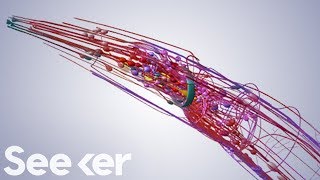Worms. They're weird, primitive creatures that seem to just squirm around senselessly.
蠕虫。他们是奇怪又原始的生物,似乎只是在无谓的蠕动。
BUT this simplistic behavior is exactly what we are looking for in our endeavours to digitize a living brain.
但这种简单化的行为正是我们在数字化活脑工作中所要寻找的。
Now look at this. This looks like a robot being controlled by an Ewok.
现在看看这个。这看起来像一个被伊渥克控制的机器人。
But actually, this robot isn't being controlled AT ALL.
但实际上,这个机器人根本就不受控制。
What you are looking at is a copy of the brain of a Caenorhabditis elegans, or C. elegans.
你所看到的是秀丽隐杆线虫或C线虫大脑的一个副本。
This is the digital brain of a worm ON a computer chip IN a lego robot.
这是乐高机器人计算机芯片上的蠕虫数字大脑。
This little guy is a simulated brain navigating on its own.
这个小家伙是个靠自己导航的模拟大脑。
Well, navigating the best way a wormbot can.
嗯,虫虫机器人在以它最佳的方式导航。
The scientists put sensors on their robots "noses" and "tails"so if they meet a wall, they know to turn around.
科学家把传感器放在机器人的“鼻子”和“尾巴”上,这样当他们遇见一面墙时,就知道掉头了。
Just like the C.elegans.
就像C线虫一样。

But, as simple as this robot seems to be, getting to this point took a long time.
但是,像这个机器人一样简单,达到这个程度,我们花了很长时间。
Researchers spent decades looking at each and every cell in the C.Elegans, and at how each cell works with the cells around it.
研究人员花了几十年的时间来研究线虫的每个细胞以及它们与周围细胞一起工作的方式。
Then other researchers built a program that could mimic that interaction.
然后其他研究人员建立了一个模拟这种交互的程序。
Each one of these boxes represents a neuron interacting with the environment.
这些盒子中的每一个,都代表一个与环境交互的神经元。
They could do this, because scientists have a complete map of every single cell in the C.Elegans and their functions.
他们可以这样做,因为科学家们有一张C线虫全部细胞及其功能的完整的地图。
It's the worm's CONNECTOME, and it holds around 1000 cells and all 302 neurons of this little worm.
这是蠕虫的连接体,它拥有这只小蠕虫全部约1000个细胞以及302个神经元。
So, once you've digitized how every cell and neuron interact, you have the digital version of the C.Elegans brain!
所以,一旦你将每一个细胞和神经元的相互作用数字化了,你就有了C线虫大脑的数字版本!
Sort of. By simulating a brain at a cellular level, the researchers can watch the larger aspects, like movement, emerge...naturally.
某种程度上。通过在细胞水平上模拟大脑,研究人员可以观察到更大的方面,比如运动,萌生...自然而然。
Or, put another way, they turned it on and let the wormbot be a worm... bot.
或者,换句话说,他们打开它,让虫虫机器人成为一条虫,机器人。
To do this they took the connectome, some algorithms, and a precise anatomical map and combined them.
为此他们把连接体,有些算法,和一张精确的解剖图结合起来。
Then they threw it in a simulator -- which is super complicated, and I don't really understand how it all works -- but the important thing is what happened once they flipped it on.
然后他们把它扔在模拟器里——超级复杂,我真的不明白这一切是怎么运转的——但重要的是一旦他们把机器人的身体翻转过来,背部朝地会怎么样。
The robot behaved like a living C.Elegans!
机器人表现得就像只活的线虫!
Well, almost. The researchers are starting small.
嗯,差不多。研究人员正在开始小规模的研究。
They want to get the neuron's interacting with the "muscles" of the robot.
他们想让神经元与机器人的“肌肉”相互作用。
It still doesn't have independent instinct, it's not going to start looking for food or anything yet.
它仍然没有独立的本能,它不会去寻找食物或任何东西。
Those behaviours are definitely on the agenda for our researchers, but they just want to get the digital organism moving first.
这些行为肯定在我们研究人员的议程之列,但他们只是想先让这个数字生物动起来。
Now, I know what you're thinking, is this a huge step towards some crazy scientists digitizing and uploading human brains into robuts!
现在,我知道你在想什么,这是对一些疯狂科学家数字化以及将人脑植入机器人来说是一大进步!
AHH!! But, no. Not really. No.
啊!但是,不,并不。不。
These scientists are mapping this worm's brain and creating an accurate digital simulation because WE still don't know a lot about how OUR brain works.
这些科学家正在绘制这种蠕虫的大脑,并建立出精确的数字仿真,因为我们仍然不太了解我们的大脑是如何运作的。
This project's success could completely change the way we map and understand our own brain.
这个项目的成功可以彻底改变我们绘制和理解我们自己大脑的方式。
Plus, with this application we could possibly get rid of squishy living organisms in labs and could rely on computer simulations instead.
另外,这个应用可以让我们摆脱实验室里粘糊糊的生物体,依靠计算机模拟来取而代之。
There's nothing to fear…
无所畏惧...
C.elegans are only 1mm long. It will take a while before we start digitizing your brains guys.
线虫只有1毫米长。在我们开始对你的大脑进行数字化之前还有漫长的路要走。
For more science in your day, subscribe to Seeker and are you wondering how our brains power our thoughts in the first place?
想要了解你日常生活中的更多科学知识,请订阅《Seeker》,你想知道我们的大脑一开始是如何驱动思想的么?
We explain it right here.
在这里你可以获知。
Did you know that the C.elegans is the first animal and currently, ONLY animal with an entirely mapped connectome?
你知道线虫是第一个,也是目前唯一一个拥有完整映射连接体的动物吗?
Pretty cool. Thanks for watching.
很酷的。谢谢收看。











